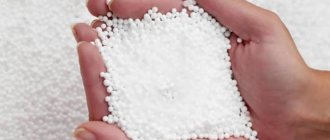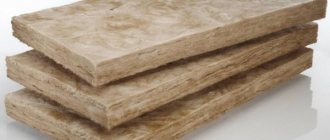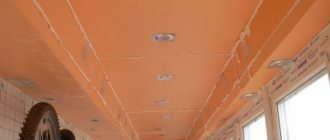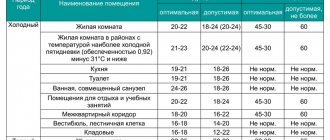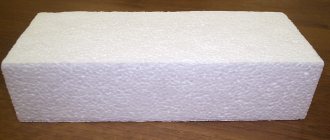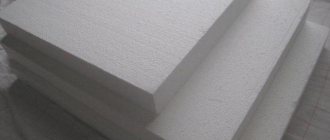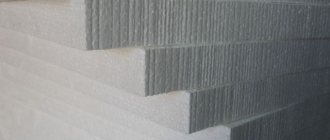What is polystyrene made of?
Before deciding how toxic it is, it is worth understanding what the polystyrene material is made of. Expanded polystyrene and all its varieties belong to the category of thermoplastics, which are based on a similar substance - styrene.
In addition to it, the composition includes:
- flame retardants. They are necessary to ensure the fire resistance of the material, which in its pure form is subject to combustion and melting even with relatively little exposure to flame;
- plasticizers. They impart solidity to the resulting product, making it stronger and more resistant to deformation and destruction;
- fillers. There can be many such substances, and all of them are designed to impart certain qualities to the material: flexibility, hydrophobicity, thermal insulation ability. The composition and list of fillers directly depends on the purpose of the final product;
- dyes. They are used to impart aesthetic qualities to the material. They play the role of safe and non-toxic pigments.
But what is the harm of polystyrene to health? Almost all of the components included in its composition, regardless of the specific type of polystyrene material: from gas-filled (expanded polystyrene) to extruded polystyrene and foam, are relatively safe to use.
Except for styrene. But its concentration, for example, in the insulation does not exceed 0.05% of the total volume. Moreover, the requirements of sanitary standards in force in Russia allow the operation of facilities, including residential buildings, with a styrene concentration tens of times higher.
Therefore, at first glance, the question of whether polystyrene is harmful to human health should be answered in the negative. But not everything is so simple - there are many nuances, including features of the use of the material.
Can polystyrene foam be harmful to human health?
Most people, when thinking about using a particular building material, first of all want to find out how safe it is for the environment and people who may be in close proximity to it. This is indeed a very important point, since many modern building materials, due to their ability to emit harmful fumes, can be used exclusively for exterior decoration of premises.
Polystyrene foam production diagram.
Quite often, people who want to insulate a room wonder whether polystyrene foam, which has excellent thermal insulation properties, is harmful.
Characteristics of polystyrene foam and its scope of application
In order to understand whether polystyrene foam is harmful, you must first understand its composition and manufacturing method. Among other things, it is necessary to consider the areas of application of the material, since it is the ways in which the material is used that will reveal possible effects on humans.
Characteristics of foam plastic.
Despite the fact that some manufacturers claim that polystyrene foam is an environmentally friendly material, the method of its production is still far from the concept of “environmentally friendly”. The production of polystyrene foam uses high-temperature liquids, including methylene chloride and pentane, which are necessary for the polystyrene foaming process.
After foaming, a sufficient number of pores are formed, that is, balls, which are components of foam sheets.
For polymerization, that is, the transformation of pores into solid elements, highly toxic substances are also used, including styrene, but during any reaction there still remains a small amount of reagents that did not enter the reaction and retain their original toxic properties.
After polymerization, the resulting round elements are soldered together into a dense mass at a temperature of 140-175°C and subsequently cut into slabs of the required size.
However, it should be noted that if the material was produced without violating the technology, then the amount of such free reagents is very small. Thus, the final product fully meets all existing Russian and international sanitary standards. Polystyrene foam is used in many areas, and not only in construction. There are many ways to use polystyrene foam:
Comparative characteristics of thermal insulation materials, including polystyrene foam, according to the degree of their harmfulness.
- external wall insulation;
- internal wall insulation;
- arrangement of sound insulation;
- construction of houses;
- polystyrene foam as packaging material.
These are not all areas of application of foam plastic. It should be immediately noted that an important condition for the safe use of polystyrene foam as insulation is careful adherence to the instructions for use.
The thing is that polymerization, which is carried out during the manufacture of this material, can also occur in the opposite direction, for example, when the material is exposed to ultraviolet rays, high temperature and some other factors.
The decomposition of the polymer always occurs with the release of a significant amount of highly toxic substances, including formaldehyde and benzaldehyde, which, in combination with styrene particles, can have a detrimental effect on human health, and in some cases lead to the appearance of mutations in children during intrauterine development.
Dangers of using polystyrene foam inside the home
The main disadvantage of polystyrene foam is its flammability, so it cannot be used in ventilated facades.
So, foam plastic as insulation, which by default is considered absolutely safe, can still have a negative effect on humans under certain conditions. It is worth saying right away that polystyrene foam is harmful to health only if the technique for using this material is neglected.
Using such material to insulate a house from the inside requires compliance with all installation rules, as well as some precautions, because this material cannot be used everywhere.
Although polystyrene foam has excellent heat and sound insulation properties and is reasonably priced, it is still worth considering some of the dangers associated with its use inside the home.
Polystyrene foam is completely safe only if it is installed correctly.
That is, the material is safe when it is part of an insulating sandwich, where it has little contact with air, the sun’s rays do not fall on it, and there is no likelihood that it will be exposed to chemicals that could lead to its decomposition and the release of harmful substances into the air.
However, many who want to take advantage of the excellent properties of this material deliberately neglect installation technology, which significantly increases the risk of harmful substances entering the air.
Although in fairness it is worth noting that even in this case the amount of toxic substances will be so small that it will not harm the body.
The health hazards of polystyrene foam when used to insulate a house from the inside lie in something else:
Polystyrene foam is completely impermeable to steam, so mold may appear in the house.
- The appearance of mold. If the material is not properly attached to the wall, a space is formed between it and the wall where condensation accumulates, which is an ideal environment for mold and mildew. These microorganisms not only harm walls, but can also cause the development of many serious diseases in humans, including endocarditis.
- Fire hazard. Despite the fact that foam plastic intended for insulation is not flammable, since it consists of 90% air, when exposed to high temperatures it begins to melt, releasing a significant amount of highly toxic, potent substances that can lead to rapid loss of consciousness. Thus, in the event of a fire, a person who finds himself in a room while the foam is melting has less chance of getting out unharmed.
- Increase in the number of rodents in the house. Sellers of this material claim that rodents do not eat polystyrene foam and carefully avoid it. In fact, rodents do not eat polystyrene foam, but they willingly chew it to make their nests.
Thus, the harm of polystyrene foam is largely indirect. With proper installation of polystyrene foam, all possible harmful aspects can be minimized, so this material can be used even indoors without harm to health.
What harm can foam plastic cause when used for exterior decoration?
The use of polystyrene foam is considered absolutely safe for humans, since even the small amount of harmful substances that can be released from this material completely dissolves in the air upon contact with warm air or moisture.
However, in this case, a very important point is the correct installation of the material. After attaching the foam plastic, it must be plastered or covered with other finishing material in order to protect the material from ultraviolet rays and heating in the summer, as this can provoke an increase in the amount of harmful substances released into the air.
Source: https://opt-stroy.net/vreden-li-penoplast-dlya-zdorovya.html
What is the danger of styrene
Before considering the harmfulness of polystyrene, it is worth understanding the features of the use and effects of its main component on the body.
Styrene (phenylethylene) is a toxic, colorless compound that is the basis of most manufactured polymers. When directly exposed to the human body, it has a pronounced toxicological effect, leading to dysfunction of the central nervous system, autonomic disorders and blood diseases.
In addition, it is worth noting the following negative effects of the substance:
- its accumulation in the liver, which, when a certain concentration is reached, can lead to pathology of the organ;
- deterioration of heart function and weakening of the heart muscle;
- influence on the formation of the fetus, the health of pregnant women;
- irritation of the respiratory tract and mucous membranes.
Fortunately, for serious disorders to occur in the body’s functioning, a person needs to receive a significant concentration of the substance. It is for this reason that the danger placed on polystyrene is greatly exaggerated. Even if a person is surrounded by insulation based on it all his life, he will not receive a dose sufficient to cause poisoning.
This substance has a pronounced cumulative effect, that is, it accumulates in the body over time. According to rough calculations by scientists, over 20 years the concentration of styrene in the body can increase 600 times compared to the original. At a constant concentration of a substance in the environment. However, in its pure form, a temperature of 25 degrees is required to release styrene into the environment. This substance becomes much more toxic when exposed to high temperatures, since its release increases many times over.
But it is important to consider that the polystyrene made from it is only harmful in the event of a fire. This is explained by the specifics of its production.
Imaginary and real harm of polystyrene foam
Claims that expanded polystyrene, decomposing during use, can cause irreparable harm to human health, causing problems with the reproductive organs, cardiovascular system and vision, appeared not so long ago. They are connected with the fact that the foam is based on a substance such as residual styrene, the toxicity of which is really high and confirmed by scientific research. However, it can cause real harm only if its content in the material exceeds the norm of 0.2%. Moreover, even in the last century, the share of styrene in polystyrene foam was significantly less, and modern manufacturers have managed to reduce it to almost zero.
Therefore, provided that you purchase a high-quality product (produced at a large enterprise in compliance with standards, and not using a homemade method) and follow the rules for using insulation, it does not pose a real threat to human health. To further protect yourself and your loved ones, you can use polystyrene foam only for insulating places, where contact of the material with humans is excluded (technical and auxiliary structures, as well as blind areas, plinths, the outer surface of the walls of residential buildings). However, polystyrene foam can still be deadly - this requires its contact with fire. Combustion products of polystyrene foam include nitrogen oxide, gaseous styrene, hydrogen cyanide and other substances that can cause problems with the respiratory system. Therefore, the best solution would be to use the material (and its self-extinguishing types) where it cannot burn, where there is no open fire and free access of air - for example, in “wet” insulation systems for facades.
Why is polystyrene not dangerous?
To fully understand whether polystyrene is harmful to humans, you should at least superficially study the technology of its production. During the manufacture of the final product, a polymerization process occurs, due to which styrene is reliably retained in the thickness of the material. Even if we take into account that polymerization in production affects only 97% of the base, the remaining 3% is infinitesimal for poisoning humans and the environment.
It is the non-polymerized styrene residues that have become the reason for numerous myths that polystyrene is harmful and should not be used.
But it is also worth considering that during the process of using the material, a gradual but inevitable process of reverse depolymerization occurs, leading to the release of styrene. It can either accelerate or slow down under the influence of the following factors:
- temperature, especially high;
- ultraviolet and infrared radiation;
- oxygen;
- moisture.
It is for these reasons that insulation based on this material should be covered during construction and used only for external decoration of premises.
However, even taking into account the obvious toxicity of styrene, there is no clear answer to the question of whether polystyrene is dangerous to health. There are several reasons that made it safe:
- numerous components and additives used in production. They reduce the toxicity and volatility of styrene, as a result of which the building material becomes less harmful;
- lamination of products. The laminate applied to the entire surface of the product prevents the process of depolymerization and the release of toxic substances.
It is for this reason that the material laminated polystyrene is environmentally friendly - at the moment it is one of the safest thermoplastics.
But is polystyrene backing harmful? Not at all. Its production is carried out using a modified technology; in addition, the material is completely covered with a floor covering - laminate. And there is absolutely no harm from such a substrate.
It would be useful to consider which is more harmless: polystyrene foam or polystyrene. As studies have shown, the toxicity of both materials is at a minimum level and, subject to operating conditions, such materials cannot harm humans and the environment. Of course, like all thermoplastics, they cannot be called environmentally friendly, but there is no significant harm from them.
Rules for the safe use of polystyrene
Walls where there are open sources of fire are not insulated with expanded polystyrene.
When using expanded polystyrene, harm to health in an apartment can be reduced or eliminated altogether if you follow the conditions of its installation and operation:
- it is prohibited to use the material to insulate internal surfaces, especially in rooms with high humidity levels;
- you should not use it when insulating metal or other types of roofs (you can when organizing ventilation);
- It is allowed to install the material in places where there are no open sources of fire or there is absolutely no risk of ignition of the product;
- Do not use damaged sheets.
Despite the fact that polystyrene foam is susceptible to ignition and can release toxic substances into the environment, it continues to be a popular material that retains heat in rooms. It can be used to insulate not only residential premises, but also industrial buildings and offices.
The main rule for the safe operation of the material is protection from the influence of external negative factors: wind, water, direct sunlight, and some solvents. In this case, it will serve for a long time and will not cause harm.

